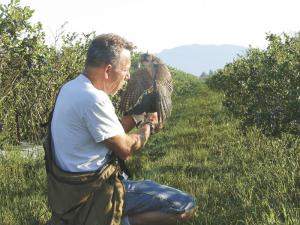2012 - Volume #36, Issue #5, Page #08
[ Sample Stories From This Issue | List of All Stories In This Issue | Print this story
| Read this issue]
Trained Falcons Scare Pest Birds Away
 |
“We set up on site with perhaps five birds and an RV with housing for a handler and the birds,” says Felger. “The handler will fly one falcon at a time, chasing birds off.”
He stresses that constant surveillance is a must with pest birds like starlings and sparrows that gather in large flocks. With a falcon or other predator flying overhead, they don’t dare land. Even a lack of birds in an area will warn other birds away. Without a falcon on site, it’s a different story.
“The pest birds fly around, and if they see scout groups of birds safely eating at a site, they land,” explains Felger. “We can chase off big flocks after damage starts, but the best time is when birds are just starting to show up.”
The goal is not to actually catch the pest birds, but simply to scare them and keep them constantly in the air. Because they need so much protein every day, they will move on if they can’t eat. Of course, that means they only fly as far down the road as they need to find food.
Felger points out that the starlings and other pest birds are actually beneficial throughout most of the year. Once the grapes and other fruit sweeten and ripen, they turn from bugs to attacking the fruit.
“It’s best if we arrive as the fruit is starting to ripen and stay throughout harvest,” says Felger. “I’ve seen people pull the program during harvest, thinking they were fine and then get hammered on the last part by birds. It doesn’t take long for the birds to figure out the falcon has left.”
Felger and his falconer and falcon crews (he has up to 20) work with vineyard owners and other fruit producers throughout California, Oregon and Washington. They also work with landfills and industrial sites.
He gets calls from other parts of the country and would like to expand. He hopes to create a regional network of associates he could refer work to. The problem is finding people who know how to work with falcons. Felger, for example, has been working with them since the 1970’s, until recently largely as recreation.
“You can have the best birds and job opportunities, but if you have inexperienced people, you’re doomed,” he says. “We are trying to get the best falconers we can, but we are also training some with less experience.”
Felger says costs vary by job. He notes that the best alternative protection available for bird damage prevention is netting. It can cost $500 per acre per year plus labor for setting it up and taking it down. Even then it often doesn’t prevent damage.
“I’ve seen starlings land on nets in such numbers they collapse the nets and pick the grapes through the netting,” says Felger. “Our price comes in considerably less, and it keeps the birds away.”
Contact: FARM SHOW Followup, Airstrike Bird Control, LLC, 4050 Tampico Rd., Atascadero, Calif. 93422 (ph 805 391-0444; bfelger@airstrikebc.com; www.airstrikebirdcontrol.com).

Click here to download page story appeared in.

Click here to read entire issue
To read the rest of this story, download this issue below or click here to register with your account number.




